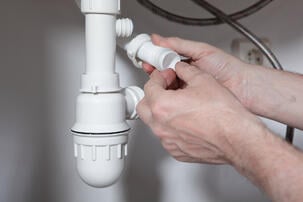The content underneath pertaining to What to Know About Plumbing: Basics, Tips, and Insights is particularly enjoyable. You should see for yourself.

Plumbing is a necessary aspect of any kind of home, in charge of providing tidy water for drinking, cooking, and bathing, along with removing wastewater safely. Understanding the essentials of home plumbing is vital for every single house owner to make sure appropriate maintenance, troubleshooting, and, if necessary, repair work. In this beginner's overview, we'll cover the basic principles of home plumbing to assist you become much more knowledgeable about just how it works.
Water Heating Unit
The water heating unit is responsible for heating water for residential usage, including bathing, food preparation, and cleansing. Common kinds of hot water heater include tank-type hot water heater, tankless (on-demand) hot water heater, and heat pump water heaters. The water heater is linked to the water system and provides hot water to plumbing components as needed.
Water drainage System
The drainage system gets rid of wastewater from your home and lugs it away to a sewer therapy center or septic tank. It contains a network of pipes, installations, and components that carry wastewater from plumbing components to the major drain line or sewage-disposal tank. Correct water drainage is essential to prevent clogs, back-ups, and sewage leaks.
Ventilation System
The air flow system aids maintain correct air pressure and prevent sewage system gases from entering your home. Air vent pipelines, additionally known as air vent heaps, prolong from plumbing fixtures to the roofing system, allowing sewer gases to escape securely outdoors. Ventilation pipelines additionally permit air to get in the water drainage system, promoting smooth wastewater circulation and stopping suction or vacuum cleaner effects.
Water System
The supply of water system brings clean water into your home from a metropolitan water source or a private well. It includes a main water line that links to your home's plumbing system, usually situated underground. A water meter measures the quantity of water taken in, while a shut-off valve permits you to manage the flow of water right into your home.
Plumbing Fixtures
Plumbing components are gadgets that deliver water to different parts of your home and consist of sinks, faucets, bathrooms, showers, tubs, and appliances such as dishwashing machines and cleaning devices. Each fixture is attached to the supply of water system through pipelines and fittings and might have its shut-off valve for maintenance or emergencies.
Common Plumbing Tools
Having the right tools handy is essential for carrying out standard plumbing repairs and maintenance tasks. Common plumbing tools consist of flexible wrenches, pipe wrenches, pliers, pipeline cutters, hacksaws, bettors, augers (or drainpipe serpents), and Teflon tape. Having these tools readily offered can aid you deal with minor plumbing concerns effectively.
Basic Plumbing Repair Services
While some plumbing fixings might require professional assistance, many typical issues can be attended to with fundamental DIY methods. Knowing exactly how to deal with a leaky tap, unclog a drain, replace a commode flapper, or repair a dripping showerhead can save you money and time on plumbing repairs.
Verdict
Understanding the basics of home plumbing is vital for every single house owner to maintain a risk-free, functional, and efficient plumbing system. By familiarizing on your own with the water system system, plumbing fixtures, drainage system, ventilation system, typical plumbing devices, and basic repair services, you can confidently resolve minor plumbing concerns and guarantee your home's plumbing system runs efficiently.
Plumbing for Beginners: A Comprehensive Guide
If you’re a beginner when it comes to plumbing, don’t worry; you’re not alone. Plumbing may seem intimidating, but with the right knowledge and a little practice, you can handle many common plumbing issues on your own. In this comprehensive guide, we will demystify the world of plumbing for beginners, providing you with the basic knowledge and skills needed to tackle common plumbing problems and even take on some DIY plumbing projects.
The Importance of Basic Plumbing Knowledge for Beginners:
First and foremost, basic plumbing knowledge gives you a solid foundation. It helps you grasp the key concepts and terminology that are essential in this field. By learning the basics, you’ll be able to build upon that knowledge and tackle more complex plumbing tasks in the future.
Having a basic understanding of plumbing also enables you to handle common issues that may arise in your home. Picture this: a leaky faucet or a clogged drain. With some basic plumbing knowledge, you’ll have the confidence to troubleshoot and fix these problems on your own. It saves you from unnecessary expenses and the hassle of waiting for a professional to arrive.
As a beginner, learning the basics of plumbing empowers you to take care of your own home. It gives you a sense of independence and self-reliance. You’ll no longer have to rely solely on professionals for every small issue that pops up. Instead, you can handle many tasks yourself, saving time and money in the process.
Remember, everyone starts as a beginner. Embrace the learning process and take small steps to expand your plumbing knowledge. There are plenty of online resources, tutorials, and even local workshops that talk about plumbing for beginners.
Essential Tools for Plumbing for Beginners
As you start your plumbing journey, having the right tools in your toolbox is crucial. Let’s explore some of the must-have tools:
Adjustable Wrench:
This versatile tool is a staple in any plumber’s toolbox. It allows you to tighten or loosen nuts and bolts of various sizes. Make sure to have an adjustable wrench with a comfortable grip.
Pipe Wrench:
A pipe wrench is specifically designed for gripping and turning pipes. It has serrated jaws that provide a strong grip, making it easier to loosen or tighten threaded pipes and fittings.
Plunger:
The plunger is a simple yet effective tool for clearing clogged drains and toilets. It creates suction when you push and pull, helping to dislodge blockages. Keep a good-quality plunger handy for those unexpected clogs.
Pipe Cutter:
When it comes to cutting pipes, a pipe cutter is your go-to tool. It creates clean, precise cuts without damaging the pipe. Look for a pipe cutter that can handle the pipe sizes you’re working with.
Hacksaw:
A hacksaw is useful for cutting through pipes, screws, and other materials. It’s a versatile tool that can handle different cutting tasks. Remember to use a blade suitable for cutting metal.
Tape Measure:
Accurate measurements are crucial in plumbing. A tape measure allows you to measure pipe lengths, distances, and dimensions accurately. Opt for a sturdy tape measure that extends a good length.
Pliers:
Pliers come in handy for various tasks, such as gripping, bending, and cutting. Slip-joint pliers with adjustable jaws are great for gripping pipes, nuts, and bolts.

As a serious person who reads about Plumbing basics: How your home plumbing works, I thought sharing that piece of writing was a smart idea. Are you aware of another individual who is curious about the subject? Feel free to share it. Thanks a lot for your time invested reading it.
Visit My Website
 Danny Tamberelli Then & Now!
Danny Tamberelli Then & Now! Mason Gamble Then & Now!
Mason Gamble Then & Now! Ashley Johnson Then & Now!
Ashley Johnson Then & Now! Heather Locklear Then & Now!
Heather Locklear Then & Now! Justine Bateman Then & Now!
Justine Bateman Then & Now!